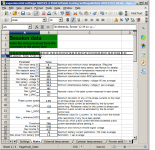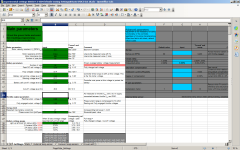Between work and home stuff and other problems with the trike (building a new fork that can handle the trike load among other things), haven't been able to get back to SFOC testing till today.
FWIW, I did test the 4503 motor itself with the generic 12fet "30a" trapezoidal sensorless controller, and it works fine with that, including what little regen that controller can do; been using it for a month that way now, without either the controller or the motor getting hot. Even if I use *only* that motor to accelerate/decelerate/cruise, leaving the other one's controller off, the motor only gets to 122F max on my commute, pushing it as hard as that little controller can manage, and that's on a 100F day, 100-105F was typical before the weather turned hot. The controller itself only gets a few degrees above ambient.
NOte that all testing below is with the trike on it's side, wheels off ground, no load.
Today, for the first time since the previous post, I connected the SFOC up to the laptop via usb-serial, left the LED Status/switch panel connected, with no other connections to anything, and got no stats back from it, but it did go thru the correct LED sequence for being connected, and had the switch off.

So I disconnected it. Then, since the previous superheating problem occured on the 4503 rightside motor, I looked up the previous parameters for the 4504 leftside motor we'd found and/or calculated, and created a settings string in a fresh S&S sheet from the Oct18 version (since that's the FW presently in the SFOC).
4T:
kV = 8.9
inductance = (307 ?) uH
phase resistance = 0.110ohms
0xF0 0x0F 0x04 0x89 0x19 0xF9 0x00 0xB3 0x04 0x74 0xFF 0xF9 0x01 0xAD 0x00 0x96 0x17 0xA8 0x16 0xB0 0x1A 0x93 0x11 0xAE 0x75 0x30 0x05 0x90 0x1C 0x1F 0x03 0xF3 0x63 0xD6
0x19 0x1E 0xFE 0xDA 0x00 0x01 0x28 0xEC 0x00 0x01 0x00 0x00 0x00 0xD6 0xFF 0xFE 0x00 0x00 0x00 0x00 0xFA 0xD6 0x00 0x00 0x00 0x00 0x01 0xC2 0x06 0x66 0x05 0x64 0xF0 0x0F

The SFOC correctly echoed back the data, and when disconnected from serial and reconected, it correctly produced stats (though they are not all valid, that's ok, it confirms the MCU is alive).
12 34 7F FF 00 00 2A CB 72 9B 01 2F 1A 30 1A 55 24 32 24 66 23 02 E7 4C 23 01 00 00 6D 67 19 6F 03 EE 13 92
Then I disconnected serial, connected up throttle (the leftside one, so different from the previous test), power, and phase wires to the 4504 on the left side, and switched it on at the Status LED panel.
This powered on normally, no error codes, and began slightly wiggling the wheel as expected.
Very gradually gave a teensy bit of throttle, and it spun the wheel backward just an instant as I let go of throttle.
Powered system off at the battery cutoff, and swapped two phase wires. Powered back on.
Very gradually gave a teensy bit of throttle, and it spun the wheel forward slowly increasing in speed until it reached the no-load max for whatever current that is. Increased throttle slightly, and it spun forward until it reached whatever the max speed was, and further increasing throttle made no increase in speed (or any other behavior). This took about 10 seconds to do, total.
I let go of throttle, and motor spun down at normal coasting / freewheeling speed, didn't appear to be decelerated by the SFOC at all, even though I have the Torque Down Ramp set to 5% (the max). This is consistent with every other attempt to make TDR brake the wheel--it doesn't do anything. I wish it did, as sometimes require regen braking to slow sufficiently depending on road conditions and cargo loading.
Anyway, as soon as I let go of throttle, I looked at the temperature monitor for the sensor I'd pressed against the SFOC's case right next to the heatsink bolt head in the middle, and saw it rapidly climbing past 135F, reaching 140F in the time it took me to reach down and turn off the battery disconnect, and continue climbing.
I then turned off the LED status panel switch, and connected the SFOC serial to the laptop, and got these stats, indicating it's max temperature was 230F (min was 45F, which isn't right, as it was 100F outside, stable for hours, at the time I did all this testing).
The motor stayed at ambient, 100F. (thermal sensor read externally rather than by SFOC, so no possibility of shorts like that which caused the damage it had to be sent back to you for last year).
12 34 7F FF 00 00 3E 62 72 4A 01 E1 1A 5D 1A 7D 04 21 04 8C 06 62 FA B6 06 21 11 6A 76 41 1A 23 01 5F 09 E7

So, whatever is causing the SFOC to heat up so rapidly with almost zero use is not the 4503 motor itself, or any of the phase wiring associated with it. Since the heating also occured with the 4504 and a different throttle, it isn't either of those, most likely.
I am still waiting for the SFOC to drop to ambient again, and then I will test it with no motor attached at all, and no throttle, and see how fast it gets to what temperature.




